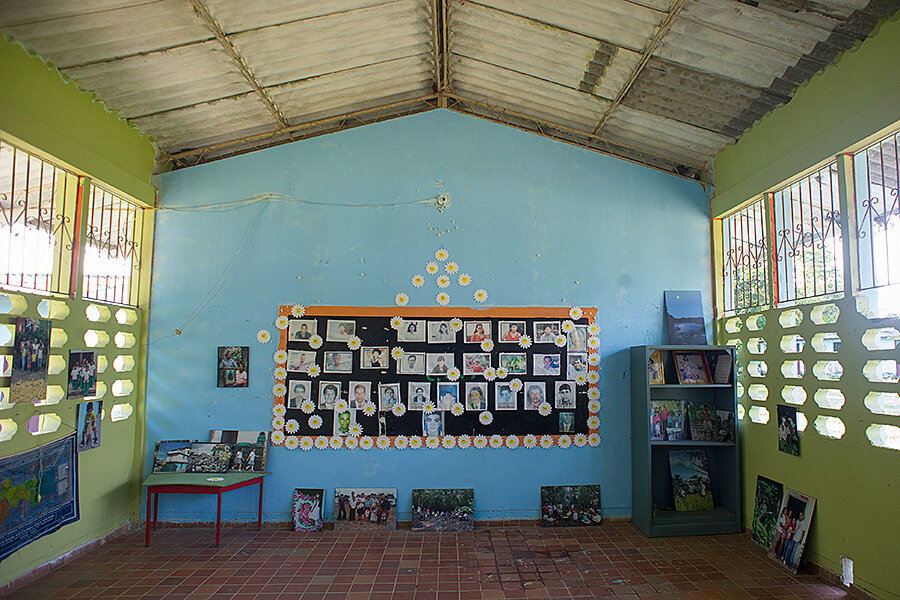Colombia on the brink of peace: Why is it such a hard sell to citizens?
Loading...
| Algeciras, Colombia
For decades, the winding mountain road leading to the town of Algeciras in south-central Colombia was littered with military barricades meant to constrain leftist guerrilla activity in one of their historic strongholds.
Today those sandbags and cement-filled barrels are gone, dismantled by local and military authorities as a gesture toward a peace deal between the government and the Revolutionary Armed Forces of Colombia, or FARC. This week's announcement of a full cease-fire and disarmament and demobilization of the rebel forces puts Colombia on the verge of ending Latin America’s longest-running war – more than 50 years of conflict that have claimed more than 230,000 lives, left tens of thousands missing, and displaced more than six million people. The final peace deal with the 7,000-strong FARC is expected to be signed later this year.
It’s a moment that the government and FARC have been building toward over the past 3-1/2 years of peace talks. And if anyone should be rejoicing, it is the people of Algeciras, where it's hard to find a resident who hasn't been a victim of the conflict.
Nestled in the lush mountains of Huila province, Algeciras has been part of a strategic corridor used by the FARC for much of its 52-year history. It’s everyone’s wish here to end the violence that has rattled this town for decades – from guerrillas sporadically opening fire on the police station and attacking the only two banks in town to planting landmines in the countryside, bombing a school, and driving hundreds from their homes.
But instead of a sense of optimism, residents here – and across the country – are overwhelmingly skeptical, going so far in some cases as to oppose the peace deal in its entirety. That’s left the government scrambling to whip up enthusiasm for a peace that most Colombians have longed for their entire lives.
"Peace? Sure it would be great, but I don't believe it will happen," says Herminda Reyes, a community leader in the village of El Paraíso, a 40-minute drive through the lush terrain from Algeciras.
After decades of living under the thumb of the guerrillas' arbitrary commanders and seeing broken promises from a succession of governments, Ms. Reyes says she doubts the FARC's commitment to ending their armed struggle and the government's capacity to make the investment needed to eliminate the social inequalities that gave rise to the rebels back in the mid-1960s.
More than half of Colombians say their worst fear is that one or both sides will fail to fully implement the accords, while 37 percent say the government is conceding too much to the guerrillas, according to a survey by polling firm Centro Nacional de Consultoría.
Gonzalo Sánchez, director of Colombia’s National Center for Historic Memory, says there is a natural concern surrounding what will happen the day after a peace deal is signed.
“It’s like jumping off a cliff. Colombians have never known their country at peace so they can’t imagine it,” he says.
'Yes to peace, but not like this’
As of today's signing in Cuba, the FARC and the government will have agreed to five of their six main negotiating points. The final steps will be hammering out the logistics of ratifying the peace deal. The government has vowed to support massive investment for rural development and to allow a demobilized FARC to recast themselves as a political party, without weapons. The FARC have committed to help eradicate the illegal drug crops that have helped finance their war, locate and destroy landmines laid by their troops, and offer reparations to their victims.
The historic accord is expected to include the terms of a full bilateral cease-fire, establish temporary zones where the FARC can gather for disarmament, a timeline for disarming, and security guarantees for demobilizing forces.
As part of a special justice deal, FARC leaders who offer full confessions of their crimes will avoid jail time, serving "alternative sentences" that could include acts of reparation to victims.
To dubious Colombians, that sounds like there will be no consequences for the thousands of crimes committed by the FARC, including kidnapping, forced disappearances, murder, torture, and forced displacement.
"We cannot accept impunity for these crimes," Rodrigo Quiñónez, a retired general, says on a recent Sunday morning while leading a signature-drive against the peace process in the capital, Bogotá. He stands under a sign that reads, "Yes to peace, but not like this."
"They have to submit to Colombian law and pay for what they have done," Mr. Quiñonez says, part of a campaign led nationally by former president and current opposition senator Alvaro Uribe, a sharp critic of President Juan Manuel Santos.
Former President Uribe has spearheaded a crusade against the peace process, arguing that the president is simply "handing the country over to terrorists." Uribe, whose military onslaught against the FARC during his two terms as president is credited with bringing the rebels to the negotiating table, says that Santos, in his quest for a peace deal, has given in too easily to FARC demands on certain reforms and on jail time.
Direct victims of the FARC are less adamant about needing to see guerrillas behind bars, but still express certain skepticism for peace here.
"What do I gain with one of those people being put in jail?" asks Myriam Rodriguez, whose nine-year-old son Anderson Devia was killed along with five other children in a 1990 FARC attack in Algeciras. "That is not going to bring back my son," she says. "They can sign a peace deal, but I won't be at peace until I die."
Knocking down ‘myths’
Santos has promised to allow Colombians to vote on the deal once it's finalized. The plebiscite, which has been approved by Congress, is under review by the Constitutional Court, though it has been challenged by critics because it would require approval from just 13 percent of voters to pass.
Santos, who is in his second term, has made the peace process with the FARC a banner of his presidency. Internationally those efforts have won him praise. But at home, Santos has the approval of just 21 percent of Colombians.
The peace process may be a victim of his low standing, argues Carlos Lemoine, president of the Centro Nacional de Consultoría. “Santos is unpopular not because of the peace process, which most people quietly support, but despite it,” he says.
The government's latest effort to promote the peace accords is a social media campaign with the hashtag #SiALaPaz (#YesToPeace). A separate campaign is aimed solely at knocking down what the government calls myths about the deal, including that the FARC will hold on to their weapons and that demobilized fighters will enjoy a hefty stipend paid for with Colombian taxpayers' money.
"I don't know who to believe," says Diana Gómez, a housewife in Bogotá who has lived through the conflict here. "I am not clear about what's happening. I want peace, of course, who doesn't? But I want to know what price society will have to pay for it," she says.
Like Ms. Gómez, a vast majority of Colombians say they don't know the specifics, although details have been published by the media, the FARC, and the government. The Centro Nacional de Consultoría poll showed that more than 80 percent of those questioned said they knew little or nothing about the deals on rural development, political participation, drug eradication, or transitional justice.
Mr. Sánchez, from the historic memory center, says part of the lack of interest has to do with the fact that even without a peace deal, conflict-related violence and overall homicide rates are at their lowest point in decades. “People don’t see the importance of reaching a peace deal because for most Colombians the conflict is a distant reality,” Sánchez says.
Since July 2015, when the FARC reinstated a unilateral cease-fire it had initially declared six months prior, the Conflict Analysis Resource Center (CERAC), a conflict monitoring group, has registered just 10 offensive actions by the FARC in which one civilian and three soldiers have been killed.
And on June 14, Santos announced that the murder rate in the country had dropped to its lowest level in 40 years, with 25.9 homicides per 100,000 residents.
A new kind of violence?
But while conflict-related deaths are down, another, subtler type of violence continues in FARC controlled areas.
Local FARC commanders have retreated from populated areas in Algeciras since the peace talks began in 2012. But milicianos, civilians who support the FARC with logistics and intelligence, continue to demand extortion payments from residents here. Jeep drivers who offer public transport to surrounding villages are charged 150,000 pesos ($50) a year to be able to circulate. Shop owners pay 1 million pesos ($330).
And while the guerrillas and their civilian supporters continue to charge what they call "taxes," they are no longer providing the services once offered, like security, residents complain. Since the FARC began retreating into the mountains at the start of the peace talks, Algeciras has seen a spike in burglaries, muggings, and other crime. "The guerrillas would take a criminal and tell him: 'You either straighten up, leave, or die,' " says Pompilio Rodríguez, a member of the town council. "The police can't do that, and so they don't have the same authority."
At the same time, other violent actors will remain after the FARC demobilize. The smaller National Liberation Army guerrilla group has been exploring its own peace process with the government, but talks have not yet begun. And new organized criminal gangs that are mostly dedicated to drug trafficking and illegal mining are spreading terror through some of the same areas of the country.
Reyes, the community leader in El Paraíso, says she hopes she’s wrong in doubting that a peace accord with the FARC will bring peace to her town.
“I hope to God I’m wrong,” she says. “Because if it fails, those of us in the countryside are the ones who stand to suffer the most.”








